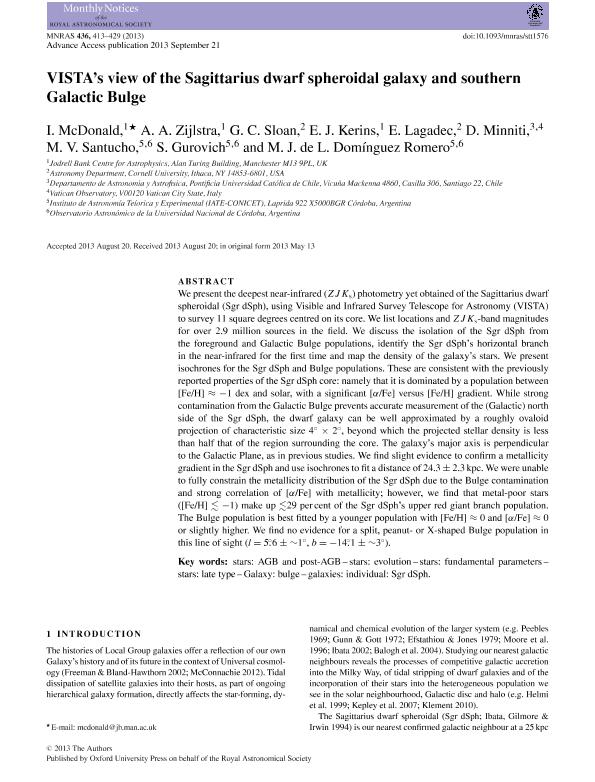Artículo
VISTA’s view of the Sagittarius dwarf spheroidal galaxy and southern Galactic Bulge
McDonald, I.; Zijlstra, A. A.; Sloan, G. C.; Kerins, E. J.; Lagadec, E.; Minniti, Dante; Santucho, María Victoria ; Gurovich, Sebastian
; Gurovich, Sebastian ; Dominguez Romero, Mariano Javier de Leon
; Dominguez Romero, Mariano Javier de Leon
 ; Gurovich, Sebastian
; Gurovich, Sebastian ; Dominguez Romero, Mariano Javier de Leon
; Dominguez Romero, Mariano Javier de Leon
Fecha de publicación:
09/2013
Editorial:
Oxford University Press
Revista:
Monthly Notices of the Royal Astronomical Society
ISSN:
0035-8711
Idioma:
Inglés
Tipo de recurso:
Artículo publicado
Resumen
We present the deepest near-infrared (ZJKs) photometry yet obtained of the Sagittarius dwarf spheroidal (Sgr dSph), using Visible and Infrared Survey Telescope for Astronomy (VISTA) to survey 11 square degrees centred on its core. We list locations and ZJKs-band magnitudes for over 2.9 million sources in the field. We discuss the isolation of the Sgr dSph from the foreground and Galactic Bulge populations, identify the Sgr dSph's horizontal branch in the near-infrared for the first time and map the density of the galaxy's stars. We present isochrones for the Sgr dSph and Bulge populations. These are consistent with the previously reported properties of the Sgr dSph core: namely that it is dominated by a population between [Fe/H] ≈ −1 dex and solar, with a significant [α/Fe] versus [Fe/H] gradient. While strong contamination from the Galactic Bulge prevents accurate measurement of the (Galactic) north side of the Sgr dSph, the dwarf galaxy can be well approximated by a roughly ovaloid projection of characteristic size 4° × 2°, beyond which the projected stellar density is less than half that of the region surrounding the core. The galaxy's major axis is perpendicular to the Galactic Plane, as in previous studies. We find slight evidence to confirm a metallicity gradient in the Sgr dSph and use isochrones to fit a distance of 24.3 ± 2.3 kpc. We were unable to fully constrain the metallicity distribution of the Sgr dSph due to the Bulge contamination and strong correlation of [α/Fe] with metallicity; however, we find that metal-poor stars ([Fe/H] ≲ −1) make up ≲29 per cent of the Sgr dSph's upper red giant branch population. The Bulge population is best fitted by a younger population with [Fe/H] ≈ 0 and [α/Fe] ≈ 0 or slightly higher. We find no evidence for a split, peanut- or X-shaped Bulge population in this line of sight (l = 5$ $_{.}^{\circ}$$6 ± ∼1°, b = −14$ $_{.}^{\circ}$$1 ± ∼3°).
Archivos asociados
Licencia
Identificadores
Colecciones
Articulos(IATE)
Articulos de INST.DE ASTRONOMIA TEORICA Y EXPERIMENTAL
Articulos de INST.DE ASTRONOMIA TEORICA Y EXPERIMENTAL
Citación
McDonald, I.; Zijlstra, A. A.; Sloan, G. C.; Kerins, E. J.; Lagadec, E.; et al.; VISTA’s view of the Sagittarius dwarf spheroidal galaxy and southern Galactic Bulge; Oxford University Press; Monthly Notices of the Royal Astronomical Society; 436; 1; 9-2013; 413-429
Compartir
Altmétricas



